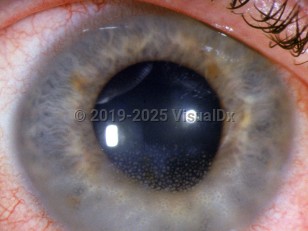Anterior uveitis is intraocular inflammation confined to the anterior chamber of the eye, namely the iris and ciliary body. It can be either acute or chronic and have infectious or noninfectious etiologies. It has a wide range of presentations from a white and quiet eye with inflammation only noted on examination with high magnification, to a painful red eye with moderate to severe inflammation, light sensitivity (photophobia), and decreased vision.
Typical symptoms include:
- Redness
- Pain
- Photophobia
- Epiphora
- Visual disturbances / blurry vision
- Red eye
- Cells and/or flare in anterior chamber
- Keratic precipitates on inner aspect of cornea
- Iris nodules
- Hypopyon (pus in the anterior chamber)
- Pupillary miosis with posterior synechiae
The cause of anterior uveitis is most often idiopathic. However, it can be seen in the setting of recent trauma (also referred to as traumatic iritis) or have autoimmune / noninfectious etiologies as well as infectious causes. Approximately one-half of patients with acute anterior uveitis are HLA-B27 positive. Systemic diseases with this association include ankylosing spondylitis, Reiter syndrome, psoriasis, inflammatory bowel disease (Crohn disease, ulcerative colitis), sarcoidosis, and tubulointerstitial nephritis and uveitis syndrome (TINU). Infectious causes include syphilis, tuberculosis, Lyme disease, herpes simplex and herpes zoster, toxoplasmosis, and histoplasmosis.
Certain systemic medications, such as rifabutin, bisphosphonates, sulfonamides, diethylcarbamazine, oral contraceptives, and etanercept have been reported to cause anterior uveitis. Neoplastic masquerade syndromes, such as primary central nervous system lymphoma, can present with a nonimmune mediated uveitis.
Overall, idiopathic causes are more frequently the cause of anterior uveitis, whereas posterior uveitis is more often caused by infectious etiologies.
Intermediate uveitis involves inflammation of the ciliary body and pars plana and manifests mainly as floaters in an otherwise quiet eye. Vision loss is often from macular edema or cataracts secondary to the chronic inflammation. A fundus examination reveals vitreous cells, "snowballs," and "snow banking" (accumulations of inflammatory cells inside the eye). This type of uveitis is associated with multiple sclerosis, sarcoidosis, Lyme disease, toxocariasis, syphilis, tuberculosis, and human T-cell lymphotropic virus type 1 infection.
Posterior uveitis is inflammation involving mainly the retina and choroid, and inflammatory cells are noted mainly in the vitreous. Causes of this include systemic lupus erythematosus, polyarteritis nodosa, granulomatosis with polyangiitis, and other "white dot" syndromes.



